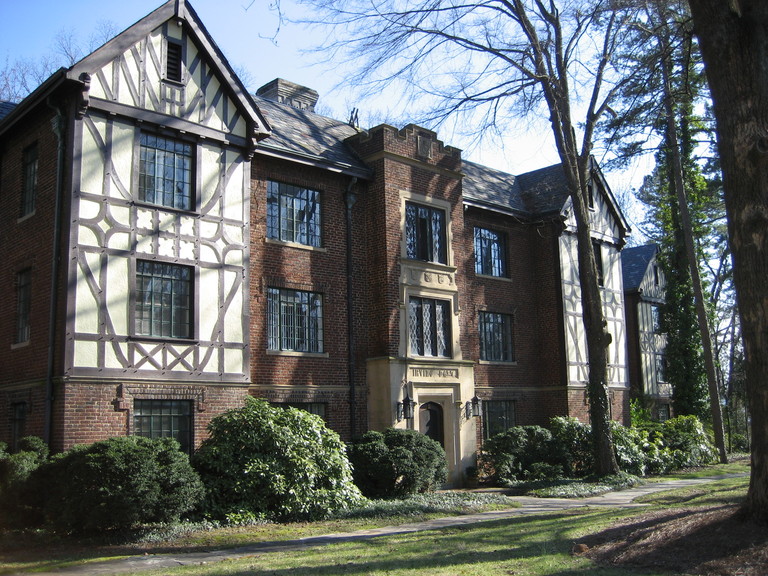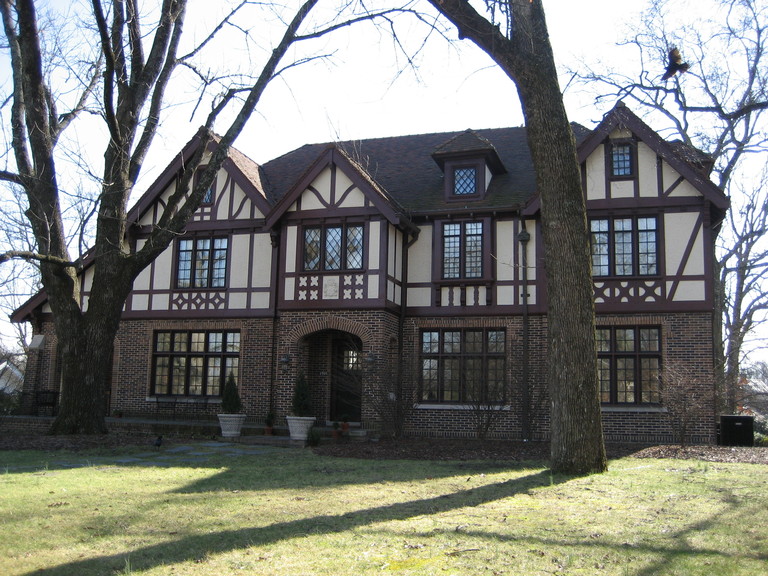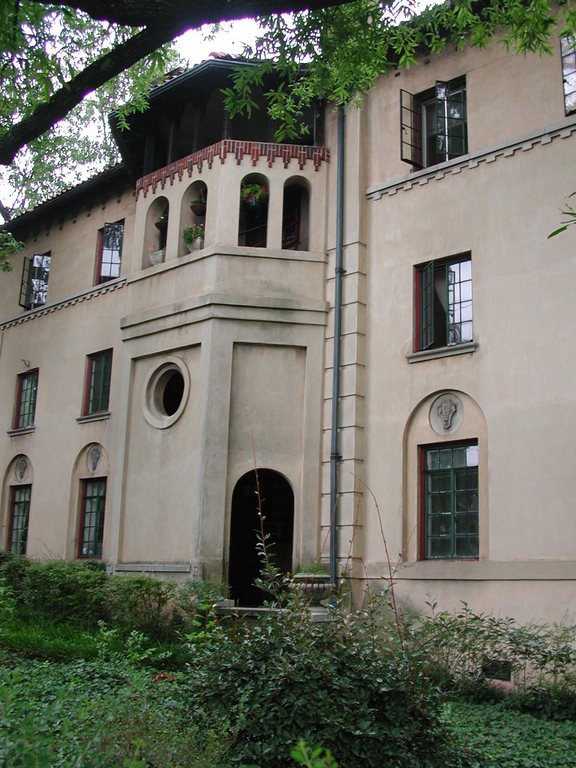Winslow, Lorenzo S. (1892-1976)
Birthplace:
Mansfield, Massachusetts, USA
Residences:
- Greensboro, North Carolina
- High Point, North Carolina
- Washington, D.C.
Trades:
- Architect
NC Work Locations:
Building Types:
Styles & Forms:
Colonial Revival; Tudor Revival
Lorenzo Simmons Winslow (August 20, 1892 - June 20, 1976), practiced architecture in High Point and Greensboro, North Carolina, in the years between the World Wars before moving to Washington DC, where he became architect to the White House.
Winslow was born in Mansfield, Massachusetts to George and Andree Hathaway. After graduating from the Mansfield High School, he attended Valparaiso University in Indiana, Ohio Northern University in Ada, Ohio, and the Massachusetts Institute of Technology in Cambridge, Massachusetts where he was trained in engineering and architecture. In 1913 he took a position as a junior draftsman with Boston architect T. Edward Sheehan where he worked on plans for a municipal building in Roxbury and several churches. When the United States entered World War I in 1917, Winslow volunteered promptly and served in the Corps of Engineers. After the war, Winslow remained in Paris and took a year to study architecture and design in Europe. This period was an important touchstone for his architectural development.
At the age of 27, Winslow returned to Mansfield to resume his career in architecture, but a chance encounter soon led him to Greensboro, North Carolina. During a winter vacation in the golfing resort of Pinehurst, North Carolina, he met Harry Barton, an architect who had moved to Greensboro from Philadelphia in 1912 and was one of the city’s leading practitioners. Barton persuaded Winslow to come to Greensboro and take a position in his growing office as senior draftsman. Winslow worked in Barton’s office from 1920 until 1923, during which time he designed county courthouses, city halls, hospitals, churches, and residential work, including several buildings in High Point. It is not clear which of the projects cited to Barton Winslow might have designed; he probably designed the High Point City Hall (ca. 1922), which featured neoclassical elements such as pediments, pilasters and a modillion cornice.
In 1924, Winslow took a position at the A. K. Moore Realty Company, a development firm that shaped the appearance of western Greensboro. Arthur K. Moore had his start in real estate with suburban developments such as Greensboro’s Fisher Park in the early 1900s, and by 1919 was developing the Westerwood neighborhoods in several phases, culminating in the Sunset Hills suburb. To promote sales, Moore employed a company architect—Lorenzo Winslow—to assist homeowners in architectural design and engineering, with the help of James R. Hollowell, a recent engineering graduate from Clemson. Many of the European and Early American-inspired houses in Sunset Hills were probably designed by the team of Winslow and Hollowell. An ad in the Greensboro Daily News proclaimed, “Mr. L. S. Winslow, a man of exceptional ability . . . has made an extensive study of home design and is therefore particularly well equipped for the important service task to which he has been assigned.”
By 1927, when Winslow established a firm in his own name in the American Exchange National Bank Building, he had a built a strong reputation in the community. Newspapers of the period illustrate the diversity of his work. He employed the Tudor Revival style for the prestigious Irving Park Manor Apartments on Greensboro’s North Elm Street, creating a residential complex of “English Tavern” architecture which was called “North Carolina’s finest” when it opened and featured modern amenities including electric refrigerators, stoves, and dishwashers. Winslow repeated the Tudor Revival style in such private residences as the brick and half-timbered Frederick E. Harllee House. He also designed several residences in more classical styles, such as the H. A. Millis House, a symmetrical design with columned entrance porch.
With the onset of the Great Depression and loss of private commissions, by 1932 Winslow moved to Washington DC to work with the Office of Public Buildings and Public Parks of the national capital and worked on several projects including the Statue of Liberty and the Washington Monument, bridges and roadways in Washington’s Rock Creek Park, and the National Training School for Boys. He also entered a competition to design a heated swimming pool for the White House, to enable President Franklin Delano Roosevelt to practice a regular swimming routine as therapy for the effects of polio. Winslow won the competition—and pleased the president. Roosevelt wrote to him, “I have just examined the new swimming pool and dressing rooms, for which I am informed you did the architectural work. Allow me to commend you for the excellent taste you have exhibited in your selection of colors, materials, and proportions. The whole result is most harmonious and agreeable to the eye. I appreciate your efforts. Very sincerely yours, Franklin D. Roosevelt.”
Winslow thereby became the architect for the White House for the next twenty years, supervising increasingly significant alterations and becoming somewhat of a celebrity, known for his partiality to tweeds, his love of the arts, his signature corncob pipe, and his ancient car. Among numerous projects, Winslow designed and reconstructed the West Wing Offices, a new East Entrance Building, a bomb shelter with tunnel leading to the Treasury Building, and new utility and kitchen areas. He added the second-floor balcony on the south side, known today as the Truman Balcony. He was also architect for the removal and reconstruction of the interiors of the White House between 1948 and 1952.
In 1953 he returned to private practice and focused mainly on restoration projects, including Georgetown Presbyterian Church and the New York Avenue Presbyterian Church, both in Washington, D. C. He was a member of many historical and fraternal organizations including the Baronial Order of Magna Charta, the Society of Mayflower Descendants, the Sons of the American Revolution, and the Arts Club of Washington. He moved to St. Petersburg, Florida, before dying at the age of 85.
- Benjamin Briggs, The Architecture of High Point, North Carolina: A History and Guide to the City’s Houses, Churches and Public Buildings (2008).
- Marvin A. Brown, Greensboro: An Architectural Record (1995).
Frederick E. Harllee House
Contributors:Lorenzo S. Winslow, architectDates:1920s
Location:Greensboro, Guilford CountyStreet Address:1705 West Market St., Greensboro, NC
Status:Standing
Type:Residential
Images Published In:Marvin A. Brown, Greensboro: An Architectural Record (1995).
H. A. Millis House
Contributors:Lorenzo S. Winslow, architectDates:Ca. 1920
Location:High Point, Guilford CountyStreet Address:SW corner of NW Main St. at Farris Ave., High Point, NC
Status:Standing
Type:Residential
Images Published In:Benjamin Briggs, The Architecture of High Point, North Carolina: A History and Guide to the City’s Houses, Churches and Public Buildings (2008).
Irving Park Manor Apartments
Contributors:Lorenzo S. Winslow, architectDates:Late 1920s
Location:Greensboro, Guilford CountyStreet Address:1800 N. Elm St., Greensboro, NC
Status:Standing
Type:Residential
Images Published In:Marvin A. Brown, Greensboro: An Architectural Record (1995).
Murphy C. and Jessie McNair House
Contributors:Lorenzo S. Winslow, architectDates:1929
Location:Winston-Salem, Forsyth CountyStreet Address:401 Sheffield Dr., Winston-Salem, NC
Status:Standing
Type:Residential
Note:Lorenzo Winslow designed the two-story Tudor Revival residence for R. J. Reynolds Tobacco Company auditor Murphy C. McNair and his wife Jessie.
Winborn Court Apartments
Contributors:Lorenzo S. Winslow, architectDates:1929
Location:Greensboro, Guilford CountyStreet Address:203 S. Tate St., Greensboro, NC
Status:Standing
Type:Residential
Images Published In:Marvin A. Brown, Greensboro: An Architectural Record (1995).



